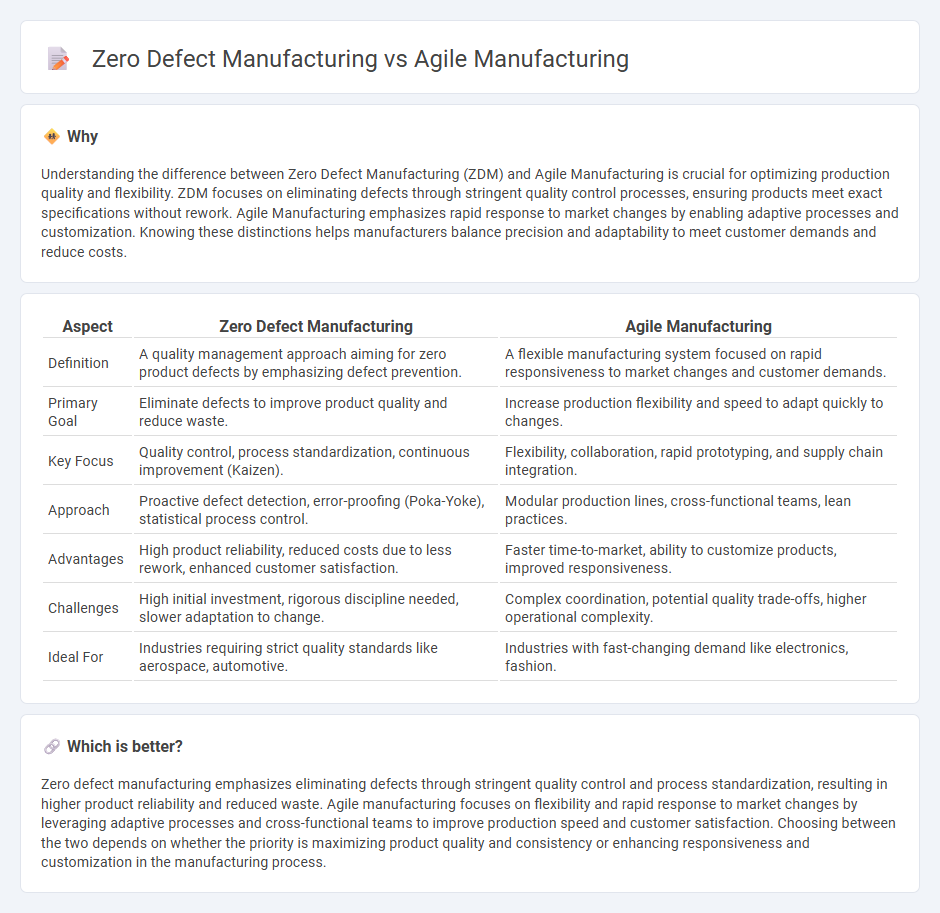
Zero defect manufacturing focuses on eliminating errors throughout the production process to ensure flawless product quality and reduce waste. Agile manufacturing prioritizes flexibility and rapid response to market changes, enabling quick adaptation in product design and production schedules. Explore these approaches to discover how they enhance efficiency and competitiveness in the manufacturing industry.
Why it is important
Understanding the difference between Zero Defect Manufacturing (ZDM) and Agile Manufacturing is crucial for optimizing production quality and flexibility. ZDM focuses on eliminating defects through stringent quality control processes, ensuring products meet exact specifications without rework. Agile Manufacturing emphasizes rapid response to market changes by enabling adaptive processes and customization. Knowing these distinctions helps manufacturers balance precision and adaptability to meet customer demands and reduce costs.
Comparison Table
| Aspect | Zero Defect Manufacturing | Agile Manufacturing |
|---|---|---|
| Definition | A quality management approach aiming for zero product defects by emphasizing defect prevention. | A flexible manufacturing system focused on rapid responsiveness to market changes and customer demands. |
| Primary Goal | Eliminate defects to improve product quality and reduce waste. | Increase production flexibility and speed to adapt quickly to changes. |
| Key Focus | Quality control, process standardization, continuous improvement (Kaizen). | Flexibility, collaboration, rapid prototyping, and supply chain integration. |
| Approach | Proactive defect detection, error-proofing (Poka-Yoke), statistical process control. | Modular production lines, cross-functional teams, lean practices. |
| Advantages | High product reliability, reduced costs due to less rework, enhanced customer satisfaction. | Faster time-to-market, ability to customize products, improved responsiveness. |
| Challenges | High initial investment, rigorous discipline needed, slower adaptation to change. | Complex coordination, potential quality trade-offs, higher operational complexity. |
| Ideal For | Industries requiring strict quality standards like aerospace, automotive. | Industries with fast-changing demand like electronics, fashion. |
Which is better?
Zero defect manufacturing emphasizes eliminating defects through stringent quality control and process standardization, resulting in higher product reliability and reduced waste. Agile manufacturing focuses on flexibility and rapid response to market changes by leveraging adaptive processes and cross-functional teams to improve production speed and customer satisfaction. Choosing between the two depends on whether the priority is maximizing product quality and consistency or enhancing responsiveness and customization in the manufacturing process.
Connection
Zero defect manufacturing and agile manufacturing are connected through their shared focus on enhancing quality and efficiency in production processes. Zero defect manufacturing aims to eliminate defects and ensure flawless product quality, while agile manufacturing emphasizes flexibility and rapid response to market changes. Integrating zero defect principles within agile manufacturing frameworks helps reduce waste, improve customer satisfaction, and accelerate time-to-market.
Key Terms
Flexibility
Agile manufacturing emphasizes rapid adaptability to changing market demands through flexible processes and customizable production systems, while zero defect manufacturing prioritizes eliminating errors to ensure consistent product quality. Agile systems excel in responsiveness and versatility, enabling manufacturers to meet diverse customer needs efficiently, whereas zero defect focuses on achieving flawless output through stringent quality control measures. Explore the unique benefits and strategic implementations of both approaches to optimize your manufacturing flexibility.
Continuous Improvement
Agile Manufacturing emphasizes flexibility and rapid response to market changes, enabling continuous improvement through iterative processes and cross-functional teamwork. Zero Defect Manufacturing prioritizes eliminating defects at every stage of production, fostering continuous improvement by rigorous quality control and process standardization. Explore detailed strategies and benefits of each approach to enhance your manufacturing efficiency.
Defect Prevention
Agile manufacturing emphasizes flexibility and rapid response to customer demands, while zero defect manufacturing prioritizes eliminating defects through rigorous quality control and continuous improvement processes. Defect prevention in zero defect manufacturing relies heavily on statistical process control and poka-yoke techniques to ensure product consistency and reduce rework costs. Explore detailed strategies and case studies comparing defect prevention in both methodologies to optimize manufacturing quality and efficiency.
Source and External Links
Agile manufacturing - Agile manufacturing is a modern production approach that enables companies to respond quickly and flexibly to market changes while maintaining quality and cost control, emphasizing adaptability, collaboration, and rapid response to customer demands.
What Is Agile Manufacturing? Lean vs. Agile - Agile manufacturing focuses on turning speed and agility into a competitive advantage by rapidly responding to customer needs, leveraging local markets, and integrating lean practices like small-batch production and continuous improvement.
Agile Manufacturing Explained: What, How, and Why - Agile manufacturing allows companies to alter production processes quickly to better meet customer demands, leading to improved satisfaction, efficiency, competitiveness, and sustainability through greater flexibility and reduced waste.
 dowidth.com
dowidth.com